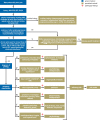Chronic Primary Pelvic Pain Syndrome in Men
- PMID: 36922749
- PMCID: PMC10511008
- DOI: 10.3238/arztebl.m2023.0036
Chronic Primary Pelvic Pain Syndrome in Men
Abstract
Background: Chronic primary pelvic pain syndrome in men (CPPPSm) can be associated with urogenital pain, urinary symptoms, sexual dysfunction, and emotional disturbance. Its clinical heterogeneity and incompletely understood pathogenesis make it more difficult to treat. This article is intended to familiarize the reader with basic aspects of the manifestations, pathophysiology, diagnostic evaluation, differential diagnosis, and treatment of this condition.
Methods: This article is based on relevant publications retrieved by a selective search of the literature, including the current guidelines of the European Association of Urology. The features of this disease pertaining to urology, psychosomatic medicine, and pain medicine are illuminated from an interdisciplinary perspective.
Results: Chronic pelvic pain appears to arise through a complex interaction of inflammatory, infectious, neurological, musculoskeletal, and psychosomatic factors. A comprehensive diagnostic work-up should be carried out to evaluate and exclude the numerous differential diagnoses. Treatment strategies are based on the clinical phenotype. Randomized controlled trials have shown that significant relief can be achieved with a variety of drugs and non-pharmacological treatments, selected according to the manifestations of the condition in the individual case. Attention must be paid to treatment-specific adverse effects.
Conclusion: The management of patients with CPPPSm should consist of a comprehensive differential diagnostic evaluation and an individually oriented treatment strategy.
Figures

References
-
- Fall M, Baranowski AP, Berghmans B, et al. EAU guidelines on chronic pelvic pain Edn Present EAU Annu Congr Amsterdam 2022. https://d56bochluxqnz.cloudfront.net/documents/full-guideline/EAU-Guidel... (last accessed on 5 June 2023) 2022 ISBN 978-9.
-
- Clemens JQ, Meenan RT, O’Keeffe Rosetti MC, et al. Prevalence of and risk factors for prostatitis: population based assessment using physician assigned diagnoses. J Urol. 2007;178:1333–1337. - PubMed
-
- de la Rosette JJ, Hubregtse MR, Meuleman EJ, Stolk-Engelaar MV, Debruyne FM. Diagnosis and treatment of 409 patients with prostatitis syndromes. Urology. 1993;41:301–307. - PubMed
-
- Krieger JN, Nyberg LJ, Nickel JC. NIH consensus definition and classification of prostatitis. JAMA. 1999;282:236–237. - PubMed
Publication types
MeSH terms
LinkOut - more resources
Full Text Sources
Medical

